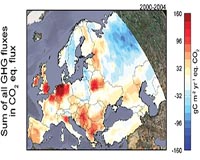 |
Tokyo (UPI) Apr 8, 2010 Tokyo has launched Asia's first mandatory cap-and-trade scheme in an effort to reduce emissions. The initiative could set a national standard. While Japanese Prime Minister Yukio Hatoyama has been pushing for a nationwide carbon-trading scheme that would help fulfill his campaign pledge to cut emissions by 25 percent from 1990 levels over the next decade, the ruling coalition has yet to agree on details. Tokyo aims to cut its emissions by 25 percent compared with 2000 levels by 2020. Under Tokyo's plan, about 1,330 offices, commercial buildings and factories that together account for one-fifth of the city's emissions would be required to reduce carbon output by 6 percent to 8 percent on average between 2010 and 2014, compared with their highest three-year average from 2002 to 2007. Office buildings are subject to an 8 percent goal and factories face a 6 percent target. Under the new rules, office-tower owners would be permitted to ask tenants to reduce energy use or help pay for carbon credits. In the second phase of the plan -- fiscal 2015 to 2019 -- commercial buildings and factories would be required to cut emissions by 17 percent from base-year levels. To comply with the emissions targets, offices and factories in Tokyo can implement their own energy-saving measures or, under a cap-and-trade system, buy emissions credits from other entities that have reduced emissions beyond obligatory levels. They can also purchase credits earned through reduction efforts by small and medium-sized companies in Tokyo. Another option is to purchase renewable energy certificates issued by power generators. Actual trading under the mandatory system in Tokyo is set to begin in fiscal 2011. Tokyo's emissions targets are "achievable," said Toru Morotomi, a professor at Kyoto University, the Financial Times reports. He estimates that the majority of businesses will recoup the cost of improving their energy efficiency in three to five years through lower bills. "After that, the savings become profit," he said. Tokyo accounts for about 5 percent of Japan's greenhouse gas emissions. "Sooner or later, we will no longer be able to emit massive amounts of carbon dioxide without any restrictions," said Teruyuki Ono, responsible for climate strategy at the metropolitan government's environment bureau, Kyodo News reports. "Transforming economic activities and facilities into low-carbon models will help Tokyo continue to develop in a sustainable manner and provide incentives to companies willing to do business here," said Ono.
Share This Article With Planet Earth
Related Links Carbon Worlds - where graphite, diamond, amorphous, fullerenes meet
 Europe still split over carbon tax at border
Europe still split over carbon tax at borderBrussels (AFP) March 26, 2010 European leaders remained divided over whether or not to slap a carbon tax at EU borders at a two-day EU summit that wound up Friday. French President Nicolas Sarkozy urged European Union leaders to agree to such a tax following the collapse of the Copenhagen climate summit. But EU sources said some of the 27 heads of state and government remained sceptical, with Austrian Chancellor Wern ... read more |
|
| The content herein, unless otherwise known to be public domain, are Copyright 1995-2010 - SpaceDaily. AFP and UPI Wire Stories are copyright Agence France-Presse and United Press International. ESA Portal Reports are copyright European Space Agency. All NASA sourced material is public domain. Additional copyrights may apply in whole or part to other bona fide parties. Advertising does not imply endorsement,agreement or approval of any opinions, statements or information provided by SpaceDaily on any Web page published or hosted by SpaceDaily. Privacy Statement |